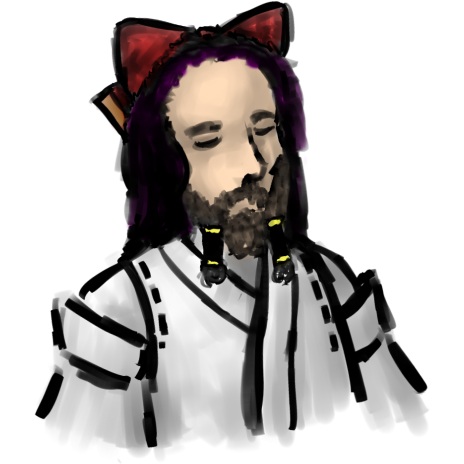- 📝 Posted:
- 🚚 Summary of:
- P0214, P0215
- ⌨ Commits:
158a91e...414770c,414770c...3123c9d- 💰 Funded by:
- Ember2528, Yanga
- 🏷 Tags:
Last blog post before the 100% completion of TH01! The final parts of
REIIDEN.EXE would feel rather out of place in a celebratory
blog post, after all. They provided quite a neat summary of the typical
technical details that are wrong with this game, and that I now get to
mention for one final time:
- The Orb's animation cycle is maybe two frames shorter than it should
have been, showing its last sprite for just 1 frame rather than 3:
- The text in the Pause and Continue menus is not quite correctly centered.
- The memory info screen hides quite a bit of information about the .PTN buffers, and obscures even the info that it does show behind misleading labels. The most vital information would have been that ZUN could have easily saved 20% of the memory by using a structure without the unneeded alpha plane… Oh, and the REWIRTE option mapped to the ⬇️ down arrow key simply redraws the info screen. Might be useful after a NODE CHEAK, which replaces the output with its own, but stays within the same input loop.
But hey, there's an error message if you start REIIDEN.EXE
without a resident MDRV2 or a correctly prepared resident structure! And
even a good, user-friendly one, asking the user to launch the batch file
instead. For some reason, this convenience went out of fashion in the later
games.
The Game Over animation (how fitting) gives us TH01's final piece of weird
sprite blitting code, which seriously manages to include 2 bugs and 3 quirks
in under 50 lines of code. In test mode (game t or game
d), you can trigger this effect by pressing the ⬇️ down arrow key,
which certainly explains why I encountered seemingly random Game Over events
during all the tests I did with this game…
The animation appears to have changed quite a bit during development, to the
point that probably even ZUN himself didn't know what he wanted it to look
like in the end:
Finally, we get to the big main() function, serving as the duct
tape that holds this game together. It may read rather disorganized with all
the (actually necessary) assignments and function calls, but the only
actual minor issue I've seen there is that you're robbed of any
pellet destroy bonus collected on the final frame of the final boss. There
is a certain charm in directly nesting the infinite main gameplay loop
within the infinite per-life loop within the infinite stage loop. But come
on, why is there no fourth scene loop? ![]() Instead, the
game just starts a new
Instead, the
game just starts a new REIIDEN.EXE process before and after a
boss fight. With all the wildly mutated global state, that was probably a
much saner choice.
The final secrets can be found in the debug stage selection. ZUN
implemented the prompts using the C standard library's scanf()
function, which is the natural choice for quick-and-dirty testing features
like this one. However, the C standard library is also complete and utter
trash, and so it's not surprising that both of the scanf()
calls do… well, probably not what ZUN intended. The guaranteed out-of-bounds
memory access in the select_flag route prompt thankfully has no
real effect on the game, but it gets really interesting with the 面数 stage prompt.
Back in 2020, I already wrote about
📝 stages 21-24, and how they're loaded from actual data that ZUN shipped with the game.
As it now turns out, the code that maps stage IDs to STAGE?.DAT
scene numbers contains an explicit branch that maps any (1-based) stage
number ≥21 to scene 7. Does this mean that an Extra Stage was indeed planned
at some point? That branch seems way too specific to just be meant as a
fallback. Maybe
Asprey was on to something after all…
However, since ZUN passed the stage ID as a signed integer to
scanf(), you can also enter negative numbers. The only place
that kind of accidentally checks for them is the aforementioned stage
ID → scene mapping, which ensures that (1-based) stages < 5 use
the shrine's background image and BGM. With no checks anywhere else, we get
a new set of "glitch stages":
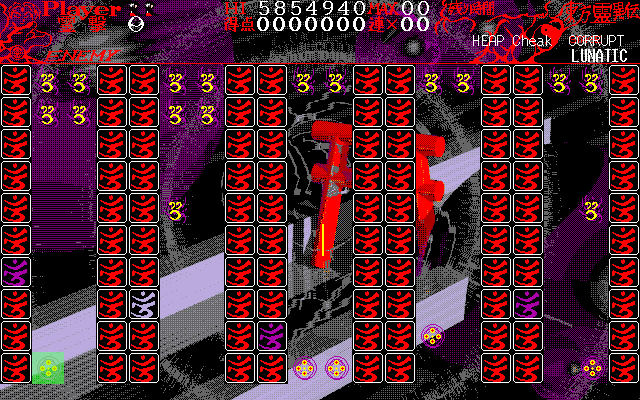
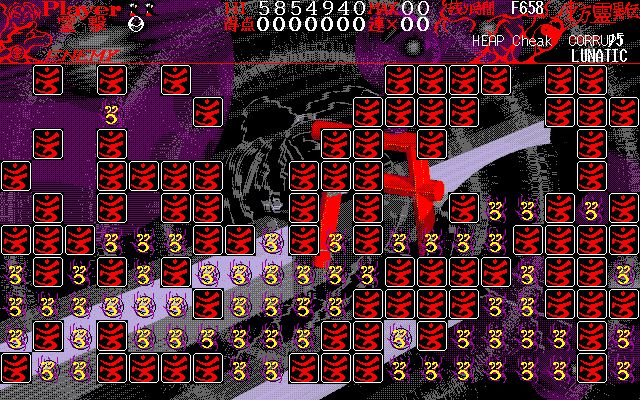
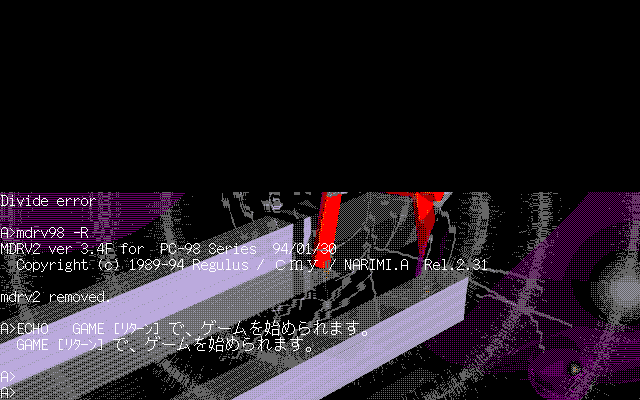
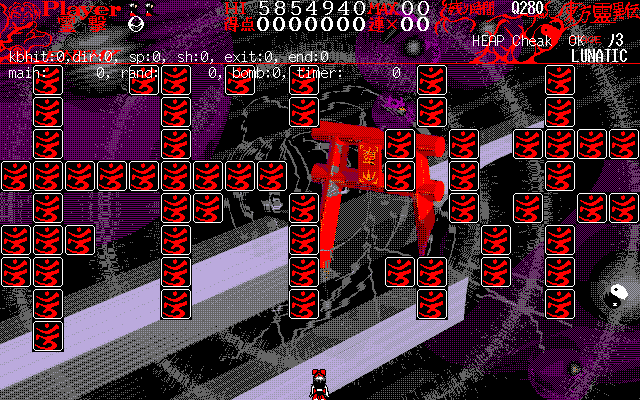
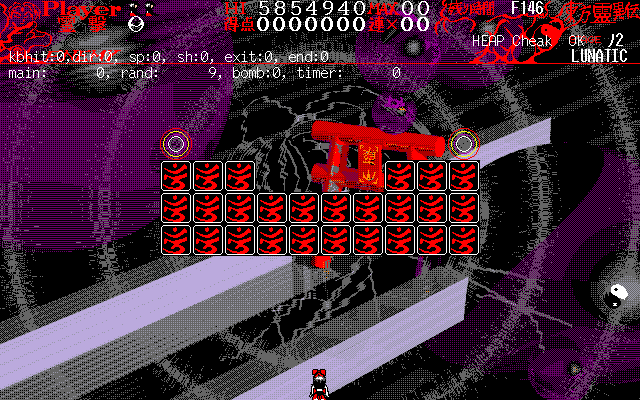
The scene loading function takes the entered 0-based stage ID value modulo
5, so these 4 are the only ones that "exist", and lower stage numbers will
simply loop around to them. When loading these stages, the function accesses
the data in REIIDEN.EXE that lies before the statically
allocated 5-element stages-of-scene array, which happens to encompass
Borland C++'s locale and exception handling data, as well as a small bit of
ZUN's global variables. In particular, the obstacle/card HP on the tile I
highlighted in green corresponds to the
lowest byte of the 32-bit RNG seed. If it weren't for that and the fact that
the obstacles/card HP on the few tiles before are similarly controlled by
the x86 segment values of certain initialization function addresses, these
glitch stages would be completely deterministic across PC-98 systems, and
technically canon… ![]()
Stage -4 is the only playable one here as it's the only stage to end up
below the
📝 heap corruption limit of 102 stage objects.
Completing it loads Stage -3, which crashes with a Divide Error
just like it does if it's directly selected. Unsurprisingly, this happens
because all 50 card bytes at that memory location are 0, so one division (or
in this case, modulo operation) by the number of cards is enough to crash
the game.
Stage -5 is modulo'd to 0 and thus loads the first regular stage. The only
apparent broken element there is the timer, which is handled by a completely
different function that still operates with a (0-based) stage ID value of
-5. Completing the stage loads Stage -4, which also crashes, but only
because its 61 cards naturally cause the
📝 stack overflow in the flip-in animation for any stage with more than 50 cards.
And that's REIIDEN.EXE, the biggest and most bloated PC-98
Touhou executable, fully decompiled! Next up: Finishing this game with the
main menu, and hoping I'll actually pull it off within 24 hours. (If I do,
we might all have to thank 32th
System, who independently decompiled half of the remaining 14
functions…)
